Dear Reader, in this age of AI created content, please support with your goodwill someone who works harder to provide the human-made. Sign up at the top of the lefthand column or bottom of this page. You will receive my hand illustrated monthly newsletter RESTORE NATURE and access to the biodiversity garden design course as I write...and nothing else, I respect your time. I am also removing the advertizing as best I can as its become intrusive inappropriate and pays me nothing.
How to conserve water
rain harvesting, recycling grey water, water-wise gardening and landscape restoration
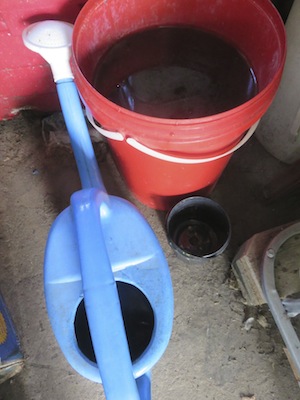 how to conserve water while bodybuilding, or a primitive irrigation system ?
how to conserve water while bodybuilding, or a primitive irrigation system ?The need to save water
The reason we need to know how to conserve water is that the most solid basis for prosperity since the beginning of history, is built not on things that are dug out of the ground, but things which have their roots in the ground.
If we are to grant credence to Jared Diamond’s theory of the history of everyone Guns, Germs and Steel, civilizations have risen based on their agriculture and the fertility of their soil, and sunken back into oblivion because they overstretched the resources of the ecosystems they depended on. One of these resources is soil and another is water. They are codependent. This group of articles deals with saving water from the various water streams in the urban home, water tanks, both cast concrete and masonry, as well as ferrocement, from casting a base, to building the walls, a workshop on gray water system basics, how to build a grey water wetland or wicking bed biofilter for growing veggies, how to make potash soap that does not damage fertility in such a closed system and pond building with a series of 'how to' photo albums on our pond building process, one deals with creating the concrete tank itself, two with inserting the liner and three with filling it up and connecting the plumbing circuitry. There is also waterwise gardening and you can refer to my articles on permaculture soil management which is crucial to saving water on a global scale, and grey water hacks which all help with water conservation.
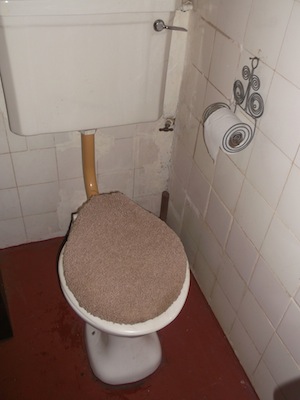 Robber in the bathroom: the biggest water waster
Robber in the bathroom: the biggest water wasterGreat demand for water
Through the centuries, greater and greater demands are made on resources like water and land. The reasons are that human kind has enormously increased in number, putting a strain on what used to be adequate water resources. But demand has also increased due to rising expectations. Where our grandparents made use of the long drop, or the bucket and cart systems of disposing of human feces, which use no water, we expect water borne sewerage, and our washing machines use vast amounts of water. Water usage in the domestic domain alone has become increasingly wasteful. We expect water on tap and in ever greater quantities per person as so called standards of living rise. But this is not all. Industry is ahead of domestic consumption and one of the most water intensive and water polluting industries in the world is paper production.
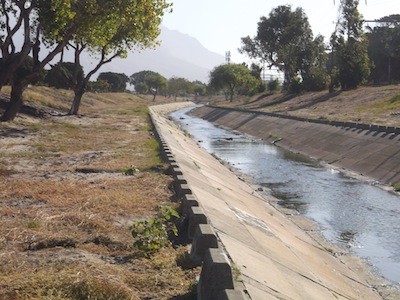 rivers fast tracked to the sea desiccate the land
rivers fast tracked to the sea desiccate the landWhat is real cleanliness
and progress ?
Is this runaway, inflationary use of our water resources really a sign of progress ? Can we call it a high standard of living to reach obsessive levels of cleanliness within our homes when this pollutes the ecosystems beyond our homes. Are we really being ‘clean’ when we just shift all the filth and destruction we produce with our wasteful habits out of sight. We need to reduce plastic pollution in our rivers and oceans. With an ever greater diversity of harmful cleaning agents in the home, and ever increasing industrial production, the world outside our homes becomes our cesspool. We take water from natural systems which need it badly and return it full of toxic substances.
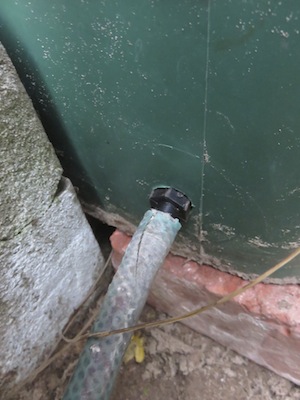 a flexible hose on a rain bin allows storage and easy targeted watering when needed
a flexible hose on a rain bin allows storage and easy targeted watering when neededCentralized supply
versus
self sufficiency
As our cities grow their centrally organized supply lines become overtaxed. External factors like oil crises or wars in distant countries, or acts of God like fires, floods and tornadoes can take them over breaking point. We will have much greater security of supply if we decentralize provision a little, provide for ourselves as much as possible, collect and purify our own water, dispose of our own sewerage safely, generate our own power and grow our own food. The great new cities of the world are too vast and chains of supply are too vulnerable to be sustainable if anything ‘goes wrong’.
Climate change
In addition to the increased demands on our water resources, the global climate changes bring less rain. All in all our water resources are under enormous strain and the individual is almost obligated to reduce water consumption for the sake of the common good.
How to conserve water
by undoing some of the damage that is being done
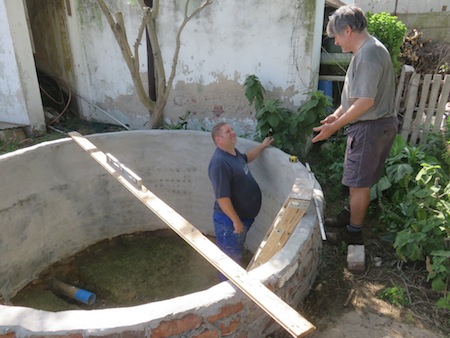 how to conserve water in a tank purposed for fish, people and rain water storage
how to conserve water in a tank purposed for fish, people and rain water storageBuild your private water
storage capacity
There are so many ways to store rain water. I will be doing several articles on low budget means, from concrete tanks to plastic barrels.
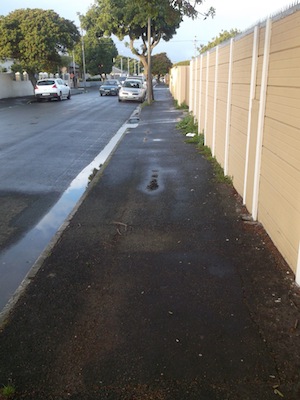 removing most of the trees which used to grow in this street is not how to conserve water
removing most of the trees which used to grow in this street is not how to conserve waterStop removing vegetation that is adapted to local climates
In addition to increased demand for water, and climate change, there is a feedback loop with vegetation cover. As plant cover is removed for urbanization, or farming, the land dries out more, because trees produce water vapour, which produces rain.
Before humans populated areas of the world, these areas existed without us, and without piped water, for millions of years. In the Cape, the native vegetation did well with our weather patterns.
Removing native vegetation is a double insult to the land. We worsen drought by replacing the hardy native vegetation with grass lawns which do not trap moisture from the sea or mist as effectively, and die off in summer leaving naked earth that dries out.
Historical eco-disasters due to removal of native vegetation
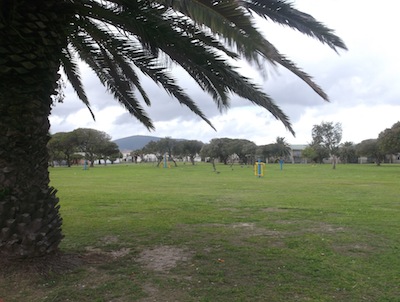 The ubiquitous grass and palm trees: not how to conserve water
The ubiquitous grass and palm trees: not how to conserve waterAncient Greece was wooded, with shady forest glades and rippling brooks. By the time of Plato the planting of exotic olive orchards which started around 400 BC had desertified Greece permanently (Lynn Alley 1995). Replacement of indigenous vegetation has had dire ecological consequences on the French Mediterranean coast in the mid twentieth Century (Gildemeister 1995:18) where English gardening fashions took hold with lawns, roses and palm trees. But the deforestation of the Mediterranean began with Solomon (Gildemeister 1995). The fertile crescent once was true to its name. At that time it was wooded and full of permanent streams and forests. The deforestation and desertification of the fertile crescent began about 10000 BC (Diamond 2005:410, 455). South Africa also has its own story of deforestation. Forests mentioned in the diaries of Van Riebeek, the first Dutch governor, no longer exist. But deforestation started long before the Dutch with the Khoekhoe herders burning forest and bushland to create pasture. I will not address the problem with the British bringing exotic trees from Australia, its common knowledge that these have suppressed local vegetation and dried up our rivers.
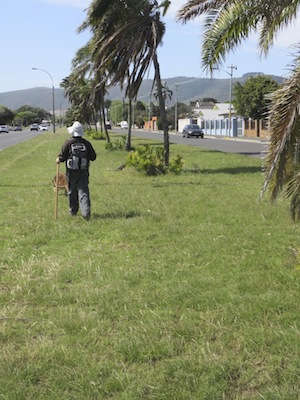 for some people this type of landscaping never gets old
for some people this type of landscaping never gets oldWhy our vegetables are exotics
In the Cape, the native foods thrived in our weather patterns, whereas nearly all our present vegetables and food plants are exotic and are not able to survive without life support in the form of extra water and nutrients. This is firstly because our vegetables are often from much wetter zones of the earth where they were first domesticated. But it is also because this area was inhabited first by Hunter gatherers and then by nomadic pastoralists and thus our local food plants were never domesticated.
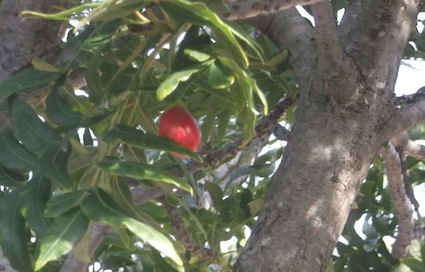
We still have a card up our sleave, Dr Diamond
Jared Diamond’s theories exclude the possibility of new plant domestication, in any part of the world, claiming that all suitable plants have been domesticated, globally. There are places where local plants may have fallen through the net for differing reasons. Local soils are widely known to be nutrient poor and the vegetation, called Fynbos, is adapted to low nutrient soil and is itself largely of low nutrient value. But it did manage to sustain mobile groups of people and animals since the earliest appearance of modern man in Africa, and it saved the small numbers of early European settlers from starvation. Mobility does not match well with agriculture, and the settlers were resistant to local plant knowledge unless ill or dying of hunger. There may be suitable plants here that were not domesticated due to these complications. To save water, these local highly drought resistant food plants should at least be investigated.
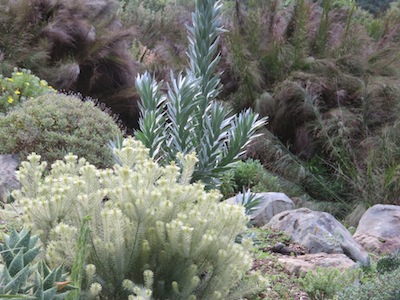 how to conserve water by changing to Fynbos colours
how to conserve water by changing to Fynbos coloursHarm done by exotic gardening 'knowledge'
We at the Cape have the richest flora per area in the world, but in local libraries most of the books recommend exotic plants for gardens. The ‘types’ or styles of garden in the popular imagination contribute to this mindset. They are based on the appearance of vegetation in areas of the world, mostly the place of origin of the colonizers, which have high rainfall. This imitation of the ‘mother country’ in Europe leads to the excessive use of water to maintain a lush ‘English’ appearance.
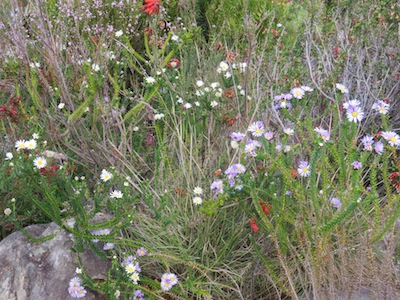 There is always a preponderance of brown in the Fynbos
There is always a preponderance of brown in the FynbosA garden style based on the richest plant kingdom on earth ?
There is no style or garden type based on the honest, unaugmented appearance of the Fynbos and its ecological pattern of seasonal desiccation. Even our botanic gardens are based on showcasing prize specimens in settings which ‘look lush’ all year with vast lawns and rainforest trees, and do not imitate local vegetation patterns.
Despite the obvious beauty of the Fynbos, there is no style consisting of Bonzai like bushes, twisted and stunted by the harsh conditions, or slope topped thickets shaved smooth by the roaring winds, there is no room for brown and dry sticks among the spring flowers, or restio reeds with an understory of bulbs, succulents and spiky aromatic herbs, and creeping thorns edging winding paths of coarse sand or pebble, and there is certainly no style which sets a fashion for a garden to become scorched by fire or sere with infinitely diverse subtle dry browns and velvety grays in the summer heat.
Though the Fynbos is more beautiful than the most luscious paradisium, it must be squeezed into the established frame of European garden design. Curators of Kirstenbosch Gardens our national botanic garden can even fall into this aesthetic role model denial-of-the-dry-season trap. You can take your pick from the ‘garden types’ below to find ecological error.
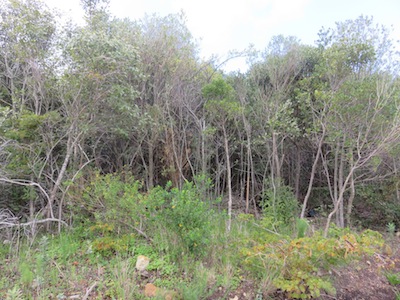 a young forest of native trees planted at Kirstenbosch
a young forest of native trees planted at KirstenboschThe water killer garden styles
The most common garden types which gardeners have seen and desire is the rose garden, the flower garden with brightly coloured annuals in borders of different colours (Kirstenbosch through the year), the Californian style palm and lawn garden (guilty again), the tropical garden, the rockery with cactuses, the English garden with a profusion of chaotic diverse form like foxgloves and dahlias, the European herb garden with box hedges, the European style vegetable garden planted with exotic European style vegetables, the all white garden, the all blue garden, the Japanese and bamboo garden, and the formal Italian garden of clipped hedges, cypress and lawns. All of these except the cactus garden have high water needs.
Many articles on this website deal with improving soil and its water holding capacity which is a major way of stopping water loss. See the articles on compost, worm farming and compost teas.
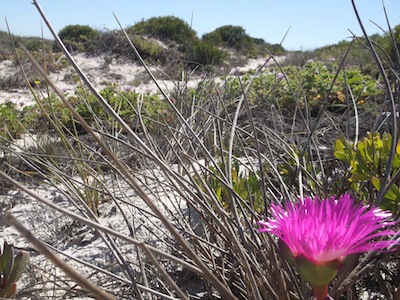 natural strandveld or dune vegetation
natural strandveld or dune vegetationRadical self acceptance
saves water and ecosystems
There is nothing as toxic and destructive as lack of acceptance of the self and it plays out at the personal and the public level and one of the signs is our plant Kingdom and its degradation.
Loss of habitat not only impacts plants but causes the extinction of the dependent insects and other organisms. Introduction of exotic plants such as legumes brings invasion of exotic nitrifying bacteria, which outcompete those found in local legumes and lead to the disappearance of these legumes. No one has investigated the 200 local legumes as possible Nitrogen fixers in agriculture, they bring in lupins. People with any kind of role to play in the spread of knowledge about plants and the management of plants have a public duty to be better informed.
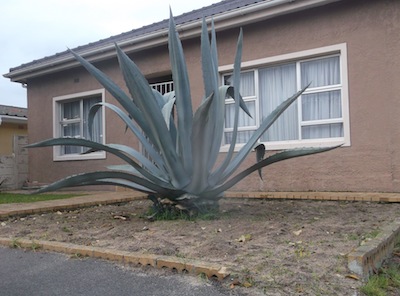 the bare plant bed will lose any water that the American Yucca saves
the bare plant bed will lose any water that the American Yucca savesTokenism in plant choice
Another danger is the token indigeneity in plant choices. Indigenous does not just mean the showy specimens found within the broader South African region. In this sense there are some indigenous plants in most nurseries. I mean whole systems of plants and their relationships which are adapted to the exact climate and soil of the specific locality, not isolated plants from other climate regions within South Africa. In other words indigenous planting is the sort of plant ecosystem which would grow there if one discounted human intervention. This is important because these plants support each other in addition to being highly adapted to local conditions.
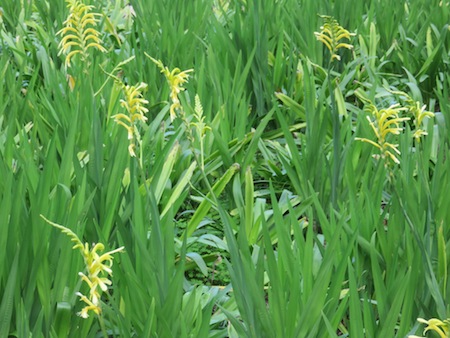 this green is unsustainable at the Cape
this green is unsustainable at the Capedamaging imported knowledge on irrigation
Our knowledge of how to conserve water is based on passing on knowledge about water saving, and this is not helped by the only available books on irrigation systems which are publicly accessible (in public libraries) being irrigation manuals written in Maine and Vermont. These books are replete with assumptions from other climatic regions with different rainfall, blessed with lakes and huge rivers, and lore about how one should and must water lawns ‘properly’, even vast lawns, to maintain a decent green. In one such manual drinking water for watering gardens is described as ideal if one can get it because there is an ‘endless supply’.
When we import our knowledge of water use from other areas of the world we are bound to end up practicing inappropriate, wasteful water use. The larger portion of land owners will assume that a lush garden is a basic human right. Importing this exotic thinking and having it as the only information on water use at the popular level, the suburban gardener’s information store, we create a general population who are water wasters, not out of will but out of lack of access to appropriate information.
Who can change the fact that we don't know
how to conserve water ?
The creation of damaging fantasies about exotic places and vegetation in the literature on gardening as well as in the gardening industry, must be held largely responsible for the negative prejudices about indigenous vegetation. From public libraries to publishing houses, local gardening magazines and authorship, nurserymen and landscape designers, from farmers to plant breeders, all take part in the dissemination of a toxic exotic fantasy and they all have a role to play in reversing this situation and the loss and devastation it causes.
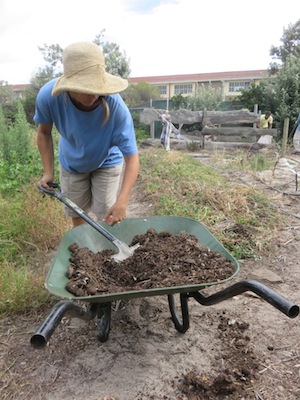 add humus to the soil and stop waterborne sewerage with sterile hot composting
add humus to the soil and stop waterborne sewerage with sterile hot compostingStaying the same is fatal.
We must learn how to conserve water.
During our recent drought the cry of the vast majority was ‘the government should provide more water’ and the poor were blamed for wasting it ! Only a few expressed the need for personal, individual change in the way we use water. Such people have laid on rain tanks, gray water systems, if they can afford it, and many have cut back their water use to a bucket per person per day or what some call ‘Medieval levels’ which are the levels the poor have to deal with anyway, drought or not. People did a huge amount of experimenting with recycling water. It gave me hope for this thirsty country.
The availability of imported knowledge, and the lack of local knowledge means people are resistant to change. The general populace could not be induced to reduce water consumption. The enormous public show of resistance and vociferous entitlement was part of a syndrome of denial. The aim of my book on water-wisdom is to provide alternative information, especially guides to saving water in the garden with a palette of practices.
The broad sweep on how to conserve water
We need to be able to make the most of our water, make better use of the water we do have. We need to make sure we use the most effective means of irrigation, water saving, water storage, and water recycling. We need to change our urban microclimate by reintroducing indigenous vegetation and trees, and pockets of indigenous forest that collect water in our water tables and we need to replace the oceans of kikuyu grass which cover 90% of public space in Cape Town. Pines which lower the water table must be replaced. Farmers and gardeners must learn to mulch. Naked earth is a crime against other people in this city. It is throwing away water other people need to drink or use to grow food.
 sick little plants permanently on life support
sick little plants permanently on life supportThe time to change is now
Cape Town is an island in a vast sea of desiccated land, the Karoo desert. If we cannot grow our own, food will have to be brought thousands of kilometres at vast expense and environmental cost. Preservation of the local urban horticultural areas like Phillipi are integral to the city’s food and water security.
Van Jaarsveld (2010) argues for the necessity of water-wise gardening to maintain the green lung of the earth and fight global climate change. The intelligent use of resources he speaks of has become more critical in South Africa with the drought. We stand at the brink of a terrible crisis. It has become a prosocial act to have a garden that does not need fresh mains water, and produces food, and to learn how to do this.
References
Diamond, Jared. 2005. Guns,
Germs and Steel. A Short History of Everybodyfor the Last 13,000 Years.
Vintage, Random House: Parktown, South Africa.
Gildemeister, Heidi. 1995. Mediterranean Gardening: a Waterwise Approach. UCLA Press :
Berkeley.
Alley, Lynn.1995. Lost
Arts. Library of Congress, Ten Speed Press: Berkeley.
Van Jaarsveld, Ernst. 2010. Waterwise Gardening in South Africa and Namibia. Random House
Struik: Cape Town.
------
home page with links to all the information on natural gardening
Restore Nature Newsletter
I've been writing for four years now and I would love to hear from you
Please let me know if you have any questions, comments or stories to share on gardening, permaculture, regenerative agriculture, food forests, natural gardening, do nothing gardening, observations about pests and diseases, foraging, dealing with and using weeds constructively, composting and going offgrid.
SEARCH
Order the Kindle E-book for the SPECIAL PRICE of only
Prices valid till 30.09.2023
Recent Articles
-
garden for life is a blog about saving the earth one garden at a time
Apr 18, 25 01:18 PM
The garden for life blog has short articles on gardening for biodiversity with native plants and regenerating soil for climate amelioration and nutritious food -
Cape Flats Sand Fynbos, Cape Town's most endangered native vegetation!
Apr 18, 25 10:36 AM
Cape Flats Sand Fynbos, a vegetation type found in the super diverse Cape Fynbos region is threatened by Cape Town's urban development and invasive alien plants -
Geography Research Task
Jan 31, 25 11:37 PM
To whom it may concern My name is Tanyaradzwa Madziwa and I am a matric student at Springfield Convent School. As part of our geography syllabus for this
"How to start a profitable worm business on a shoestring budget
Order a printed copy from "Amazon" at the SPECIAL PRICE of only
or a digital version from the "Kindle" store at the SPECIAL PRICE of only
Prices valid till 30.09.2023







